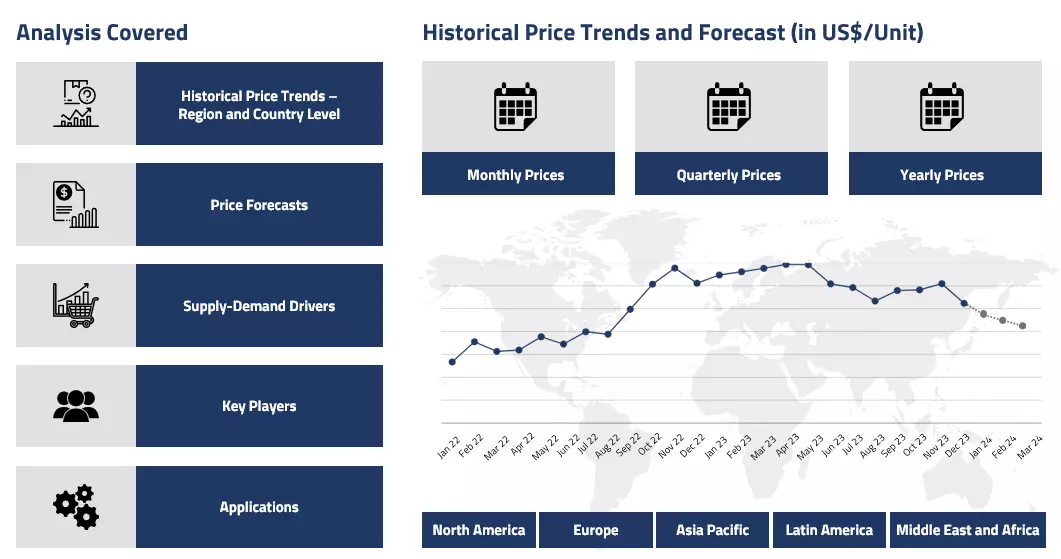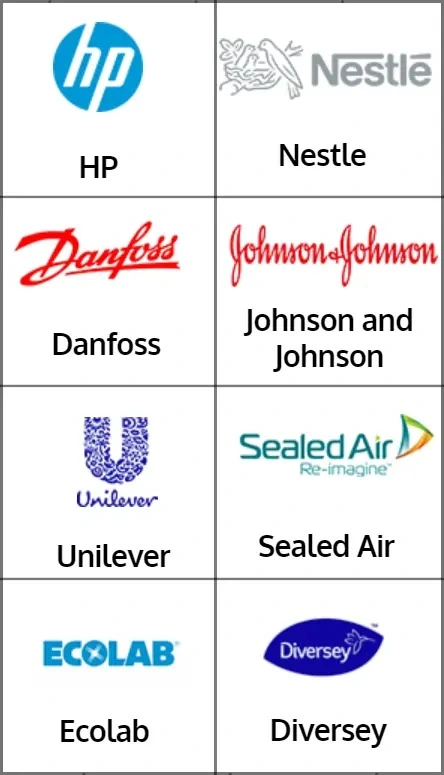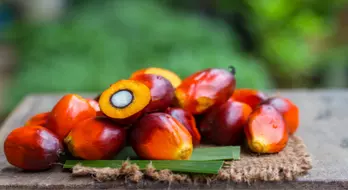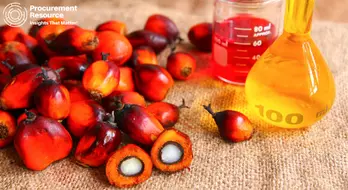Product
Palm Kernel Oil Price Trend and Forecast
Palm Kernel Oil Price Trend and Forecast
Palm Kernel Oil Regional Price Overview
Get the latest insights on price movement and trend analysis of Palm Kernel Oil in different regions across the world (Asia, Europe, North America, Latin America, and the Middle East & Africa).
Palm Kernel Oil Price Trend for Q2 of 2025
Asia
In the second quarter, palm kernel oil prices in Asia went through a softening trend. In China, the market experienced downward pressure, primarily due to milder demand. Rising production from Malaysia, combined with lack of enthusiasm for palm oil buying globally, resulted in further price reductions.
Palm Kernel Oil Price Chart

Please Login or Subscribe to Access the Palm Kernel Oil Price Chart Data
The domestic market continued along the same trajectory, reflecting minimal support for any sustained recovery. In the latter part of the quarter, the market began to demonstrate very slight signs of improvement, as sales increased moderately, and palm kernel oil substitution gathered momentum. Towards the end of the quarter, the palm oil prices stabilised as trading conditions remained subdued.
Europe
European palm kernel oil prices declined during Q2, influenced by elevated inventory levels and a lack of buyer urgency. European seasonal imports of palm oil were lower than last year, suggesting reduced take-up by refiners and food processors. High volumes of Malaysian product hit the market coupled with minimal demand from buyers generated surplus and caused prices to soften further.
Competing edible oil prices also moved downwards, pulling palm kernel oil down with them. The market influence of these competing oils was still strong, with buyers keeping a close eye on value differences between sunflower, soybean, and palm oils. Increasing inventories contributed to the pressure, particularly as exporters cleared out huge backlogs from previous months.
North America
In the North American region, palm kernel oil market witnessed soft market sentiments during the second quarter of 2025. Declines in prices of competitive edible oils impacted palm oil prices negatively. Although there were occasional periods of buying interest, most often generated by spot value revisions or fears of delayed shipment, these were short-lived. Consumer demand was stagnant as producers kept their requirements in check, with uncertain price environment. Inventory at ports and among leading distributors did not decline as rapidly as expected, keeping the cautious sentiments intact.
Analyst Insight
According to Procurement Resource, looking ahead, palm kernel oil prices are expected to remain subsided globally, especially with stockpiles still high and underwhelming demand. A meaningful turnaround would likely need a clear drop in supply or a real recovery in buying from big importers.
Palm Kernel Oil Price Trend for Q1 of 2025
Asia
During Q1 2025, Asian palm kernel oil prices generally declined, suggesting a bearish market sentiment in the region. In the initial part of the quarter, prices started to dip in the face of plentiful inventories and meagre downstream demand for food and industrial sections. The availability of substitute offerings in the form of soybean and sunflower oils further depressed market action.
In spite of minor supply-side interruptions and short-term production slowdowns, global purchasing interest was subdued. Traders and refiners across markets like China reduced procurement volumes in reaction to poor margins and risk-averse sentiment fueled by price volatility.
The quarter saw sporadic price recoveries, although these were mostly unsustainable, as poor export activity and regional oversupply pressures came back quickly. The price volatility in crude palm oil markets also influenced kernel oil pricing dynamics, making traders cautious in their restocking patterns.
Europe
Palm kernel oil prices in Europe also trended similarly in the softening manner during the quarter. The market was marked by subdued offtake from oleochemical, cosmetics, and food industries owing to inflationary pressure and deforestation-linked import regulatory restrictions.
Though mid-quarter experienced a temporary price lift because of supply shortages from Southeast Asian producers, overall sentiment was weak. Purchasers preferred short-term, need-based buying over long contracts, expecting further price relaxation. Currency devaluation and increased logistics costs also affected import volumes, especially in northern Europe.
North America
The North American palm kernel oil market, saw fluctuating price trajectory throughout the said period with prices initially underpinned by tight inventories and restricted supply from key origins. However, as supply conditions normalized and demand across end-use industries such as personal care remained flat, the upward momentum diluted.
A shift toward alternative oils and declining demand for biofuel blending contributed to a subdued market. Traders remained cautious, prioritizing liquidating existing inventories over increasing purchases. The quarter ended on broadly flat levels, a reflection of the balance between better availability and poor consumption trends throughout the region.
Analyst Insight
According to Procurement Resource, in the near future, palm kernel oil price curve is likely to remain under pressure as oversupply persists, and demand growth remains sluggish in major consuming global markets.
Palm Kernel Oil Price Trend for the Second Half of 2024
Asia
Asia saw a significant rise in palm kernel oil prices during the latter half of 2024, driven by supply constraints in key producing countries. Both Malaysia and Indonesia faced challenges due to labor shortages, adverse weather conditions, and domestic policies. These production shortfalls led to tighter supplies across Southeast Asia, further straining the export market.
As Malaysia experienced reduced output during its seasonal production dip, the availability of palm kernel oil decreased, pushing prices upward. With concerns over lower inventory levels and rising production costs, buyers in the region became cautious and limited their purchases to immediate needs. Overall, palm kernel oil prices in Asia followed an upward trajectory due to the tightening supply dynamics in the region.
Europe
Palm kernel oil prices in Europe rose due to reduced supply from Southeast Asia, coupled with rising import costs. Freight disruptions and higher shipping expenses further limited the availability of palm kernel oil. Industrial demand remained steady, particularly in the biodiesel sector, where palm kernel derivatives are widely used. However, the increased costs were passed on to consumers by refiners and manufacturers, leading to higher retail prices for products containing palm kernel oil.
North America
In the second half of 2024, palm kernel oil prices in North America remained relatively stable, with a slight upward trend. The United States, a major consumer of edible oils, saw a decline in imports due to production issues in Malaysia and Indonesia. As global supply tightened, buyers were forced to secure shipments ahead of peak seasonal demand, particularly from the food processing and industrial sectors.
The rising demand for alternative oils, such as soybean and canola, helped offset some of the upward price pressure. However, shipping costs, trade disruptions, and logistical delays complicated the supply chain, preventing refiners from accumulating sufficient inventory. As input costs rose, businesses adapted, though the resulting price increases negatively impacted the end consumer.
Analyst Insight
According to Procurement Resource, the palm kernel oil price graph is expected to maintain similar movements in the near term since the supply and demand dynamics are not suggesting many noteable fluctuations.
Palm Kernel Oil Price Trend for the First Half of 2024
Asia
During the first half of 2024, palm kernel oil prices in Asia experienced significant fluctuations, initially rising due to adverse El Niño weather conditions and export restrictions, which limited supply from key producers like Malaysia and Indonesia. The early months saw elevated palm kernel oil prices driven by higher biofuel mandates and reduced production caused by dry planting conditions. However, as the second quarter progressed, palm kernel oil prices began to decline notably due to an increase in production and weakening global demand.
The favorable growing conditions led to a higher-than-expected harvest, increasing palm kernel oil availability. Despite a stronger US dollar making palm kernel oil more affordable for international buyers, global demand from industries such as food manufacturing, cosmetics, and oleochemicals slowed, further driving down prices. The market dynamics were influenced by economic slowdowns in key markets and strategic purchasing delays by buyers anticipating lower prices.
Europe
The palm kernel oil prices experienced a continuous upward trend due to a combination of adverse El Niño weather conditions, export restrictions, and higher biofuel mandates in the European countries as well. These factors significantly disrupted the global supply chain for palm kernel oil. In major producing countries like Malaysia and Indonesia, the El Niño phenomenon caused dryness, reducing palm fruit availability and cutting yields, which in turn limited palm kernel oil production. This scarcity was further escalated by shrinking reservoirs and dry planting conditions.
In Europe, while the economy showed signs of recovery, persistent service prices and supply chain disruptions, including those caused by adverse weather and delayed networks due to the Red Sea situation, further strained the import momentum of palm kernel oil. The depreciation of the euro against the dollar increased import costs, adding to the price pressures. Additionally, rising demand from end-user industries, such as food, cosmetics, and oleochemicals, coupled with limited warehouse stocks, kept prices elevated.
North America
The pricing pattern of palm kernel oil in the North American market followed a similar trail as was seen by the European and Asian countries. The rising number of biofuel initiatives increased the in-house consumption of palm kernel oil while the supply of the commodity was limited. The market players thus first utilized the carried-over inventories. However, this was insufficient, and as a result, the prices of palm kernel oil escalated. The supply chain constraints were further accelerated by the closure of Baltimore port and low water levels in Panama as well as the Suez Canal.
Analyst Insight
According to Procurement Resource, the price of Palm Kernel Oil is expected to continue its northward journey as the yearly production of raw materials and their export from Malaysia and Indonesia is likely to remain subdued, disrupting the global supply-demand equilibria of the market.
Palm Kernel Oil Price Trend for the Second Half of 2023
| Product | Category | Region | Price | Time Period |
| Palm Kernel Oil | Agriculture, Farming and Commodity | USA | 890 USD/MT | December’23 |
| Palm Kernel Oil | Agriculture, Farming and Commodity | USA | 925 USD/MT | July’23 |
Stay updated with the latest Palm Kernel Oil prices, historical data, and tailored regional analysis
Asia
The palm kernel oil prices in the Asian markets were witnessed to be wavering within confined limits throughout the said period. Due to the El Nino weather effects this year, the major producing Asian countries like Indonesia and Malaysia saw an increased palm production, which created a supply surplus in the region.
In the Chinese market, an almost declining pattern was witnessed, while the Indian market operated on a more stable side. Some minimal uptick was observed in the latter half of the fourth quarter, majorly because of the global trade disturbance caused by various geopolitical factors. Overall, a mixed market performance was witnessed.
Europe
The European palm kernel oil market was observed to be mimicking its Asian counterpart during the discussed time span. Quarter three was relatively more inclined than quarter four as the import activities were higher. As the global demand took a dip in the fourth quarter, the prices in the European market also witnessed a marginal slide. Conclusively, a very narrow range price trajectory was observed.
North America
The palm kernel oil prices were observed to be exuding a stable price trajectory in the American market throughout the said period of H2’23. The upstream situation was moderate, with sufficient stocks reaching the inventories. Similarly, the downstream situation in the American market was also steady. The freight disturbances in the latter quarter did hurdle some orders, overall, the market sentiments were lukewarm. The monthly average prices went from around 925 USD/MT in July’23 to about 890 USD/MT in December’23.
Analyst Insight
According to Procurement Resource, not much change is anticipated in the Palm Kernel Oil price trends going forward in the coming months. Given that the inventories are sufficiently stocked, the pricing dynamic appears stable.
Palm Kernel Oil Price Trend for the First Half of 2023
Asia
Palm Kernel Oil prices observed oscillating price trend in the Asian region in the first half of 2023. The prices mostly swung low; however, some positive movements could be seen during the quarter shift, primarily attributed to the rise in consumption during various festivities like the Chinese Lunar New Year and Ramadan. The high outputs by palm oil-producing countries, like Indonesia and Malaysia, further aided the fall in price trend. India imported more oil in the first quarter than the second despite falling prices, as inventories had already been oversupplied.
Europe
Almost similar market trend for Palm Kernel Oil were observed in Europe as in Asia. Prices fell throughout the first quarter because of eased and inexpensive imports from exporting Asian countries. But prices observed some positive fluctuations in the second quarter because of a rise in consumption; imports too were hurdled temporarily. But the increased demands from end consumers primarily pushed the Palm Kernel Oil prices in the second quarter.
North America
American Palm Kernel Oil market also followed the global market trend as the prices remained low. Cheaper Asian imports supported the low swinging prices. But supply-demand fundamentals were still good and supportive. In the USA, the Palm Kernel Oil prices averaged at around 982 USD/MT (CIF) in January’23 and went to about 930 USD/MT (CIF) in June 2023 with an approximate decline of about 5%.
Analyst Insight
According to the Procurement Resource, Palm Kernel Oil prices are expected to remain oscillating in the upcoming months as the inventories are running high while the consumption is stable.
Palm Kernel Oil Price Trend for the Second Half of 2022
Asia
The Asia-Pacific market showed a mixed trend in the price of palm oil. The demand from the end-user industries contributed to the increase in the prices of the commodity. However, global inflation, export ban, and limited supply of oil played a key role in dipping prices in the fourth quarter and later months of the third quarter. High inventories in the market were another reason for the fall in the prices.
Europe
The European Market saw a decline in the prices of palm oil during the third and fourth quarters of 2022. The decline is majorly attributed to the low consumer demand. The supply chain remains strong during both quarters, and the uplifting of the ban export ban from Indonesia further fueled the supply chain. All these factors led to a decrease in the prices of palm oil.
North America
The North American market saw a decline in the third quarter of 2022. The rise in inventories due to the uplifting of restrictions led to this decline. The fourth quarter also followed the same trend. The major reason was increased exports from the Indonesian market. This supported the supply, disrupting the supply-demand equilibrium and thus leading to a decline in the prices.
Analyst Insight
The prices of Palm Kernel Oil are likely to decrease during the coming month given the export ban and high inventories of the commodity in the market.
Palm Kernel Oil Price Trend For the First Half of 2022
Asia
With the absence of precious Black Sea Sunflower oil from the global market owing to the ongoing Russian and Ukrainian geopolitical stance, the prices of oilseeds and oil soared throughout the global market. With the covid 19 restrictions and the Chinese government orders to divert the palm oil supply for alternate fuel blends the price trend of palm kernel oil soared and recorded staggering values.
With the expensive trade logistics and sanctions on SWIFT payments against Russia the prices of the Bursa Malaysia Derivative palm oil averaged 1627 USD/MT on the eve of war and went to a staggering 1942 USD/MT as recorded on March 1, 2022.
With the Indonesian government banning the exports of palm oil citing domestic reasons and flooding in Malaysia, the already tight supply of palm oil was constricted further. However, the export ban was a temporary measure and the prices stabilized in the Asian market with the Indonesian government lifting the export ban. The prices of palm kernel oil went from 1811.19 USD/MT in May to 1554.50 USD/MT in June 2022.
Latin America
The situation in Latin states was far worse than in the Asian counterpart. The prices of palm kernel oil registered staggering numbers due to the lousy harvest in the region. The entire region suffered from droughts further tightening the global supply chains.
Procurement Resource provides latest prices of Palm Kernel Oil. Each price database is tied to a user-friendly graphing tool dating back to 2014, which provides a range of functionalities: configuration of price series over user defined time period; comparison of product movements across countries; customisation of price currencies and unit; extraction of price data as excel files to be used offline.
About Palm Kernel Oil
Palm Kernel Oil is known as an edible plant oil that is extracted from the kernel of the oil palm fruit. It is manufactured by the physical refining of crude palm kernel oil. Its properties as well as composition differ significantly from palm oil.
Palm Kernel Oil is generally semi-solid at room temperature unlike other oil-types which are obtained from the rest of the fruit. This oil resembles coco oil as when it is eaten, it produces a soft sensation in the mouth like cacao. Due to its neutral taste and long life, palm kernel oil can also be utilised as a substitute for cacao and fats found in milk.
Palm Kernel Oil Product Details
| Report Features | Details |
| Product Name | Palm Kernel Oil |
| Industrial Uses | Cosmetics, Food products, Solvents, Intermediates, Other |
| Supplier Database | Cargill, Incorporated, Wilmar International Ltd, BASF SE, Bunge Loders Croklaan (Bunge Limited), Natures Natural India, IOI Corporation Berhad |
| Region/Countries Covered | Asia Pacific: China, India, Indonesia, Pakistan, Bangladesh, Japan, Philippines, Vietnam, Iran, Thailand, South Korea, Iraq, Saudi Arabia, Malaysia, Nepal, Taiwan, Sri Lanka, UAE, Israel, Hongkong, Singapore, Oman, Kuwait, Qatar, Australia, and New Zealand Europe: Germany, France, United Kingdom, Italy, Spain, Russia, Turkey, Netherlands, Poland, Sweden, Belgium, Austria, Ireland Switzerland, Norway, Denmark, Romania, Finland, Czech Republic, Portugal and Greece North America: United States and Canada Latin America: Brazil, Mexico, Argentina, Columbia, Chile, Ecuador, and Peru Africa: South Africa, Nigeria, Egypt, Algeria, Morocco |
| Currency | US$ (Data can also be provided in local currency) |
| Supplier Database Availability | Yes |
| Customization Scope | The report can be customized as per the requirements of the customer |
| Post-Sale Analyst Support | 360-degree analyst support after report delivery |
Note: Our supplier search experts can assist your procurement teams in compiling and validating a list of suppliers indicating they have products, services, and capabilities that meet your company's needs.
Palm Kernel Oil Production Process
- Production of Palm Kernel Oil via Extraction
The conventional oil extraction process to manufacture Palm Kernel Oil involves frying of palm kernels in old oil or heating the dried nuts. The fried kernels are further ground to a paste in a motorised grinder. The paste is then mixed with a small quantity of water and finally heated to recover the Palm Kernel Oil.
Methodology
The displayed pricing data is derived through weighted average purchase price, including contract and spot transactions at the specified locations unless otherwise stated. The information provided comes from the compilation and processing of commercial data officially reported for each nation (i.e. government agencies, external trade bodies, and industry publications).
Assistance from Experts
Procurement Resource is a one-stop solution for businesses aiming at the best industry insights and market evaluation in the arena of procurement. Our team of market leaders covers all the facets of procurement strategies with its holistic industry reports, extensive production cost and pre-feasibility insights, and price trends dynamics impacting the cost trajectories of the plethora of products encompassing various industries. With the best analysis of the market trends and comprehensive consulting in light of the best strategic footstep, Procurement Resource got all that it takes.
Client's Satisfaction
Procurement Resource has made a mark for itself in terms of its rigorous assistance to its clientele. Our experienced panel of experts leave no stone unturned in ensuring the expertise at every step of our clients' strategic procurement journey. Our prompt assistance, prudential analysis, and pragmatic tactics considering the best procurement move for industries are all that sets us apart. We at Procurement Resource value our clients, which our clients vouch for.
Assured Quality
Expertise, judiciousness, and expedience are the crucial aspects of our modus operandi at Procurement Resource. Quality is non-negotiable, and we don't compromise on that. Our best-in-class solutions, elaborative consulting substantiated by exhaustive evaluation, and fool-proof reports have led us to come this far, making us the ‘numero uno' in the domain of procurement. Be it exclusive qualitative research or assiduous quantitative research methodologies, our high quality of work is what our clients swear by.
Related News
Table Of Contents
Our Clients

Get in Touch With Us

UNITED STATES
Phone:+1 307 363 1045

INDIA
Phone: +91 8850629517

UNITED KINGDOM
Phone: +44 7537 171117
Email: sales@procurementresource.com


.webp)


